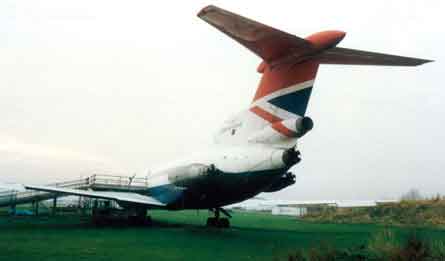In the wake of the tragic 1985 British Airtours Boeing 737 accident at Manchester in which 55 people died following an engine fire on take-off, Cranfield University undertook a detailed study into aircraft evacuations on behalf of the UK Civil Aviation Authority.
The research effort in the late 1980s, led by Professor Helen Muir, saw a retired Hawker Siddeley Trident used for a series of evacuation trials with volunteers – including on one occasion, me.
Most of the 60 participants for my trial were (poor) students who had been paid £10 ($20) to turn up, with the promise of a further £5 for each evacuation in which we were in the first 50% to escape – with the cash bonus handed over as soon as we had run down the ramps outside.
 |
|---|
© Max Kingsley-Jones 2008 Cranfield University's evacuation research used a retired Trident |
For already competitive young people, this cash bonus was to prove as compelling an incentive to escape as life itself.Wearing numbered vests for analysis purposes, we were allocated a different seat for each run to ensure that each participant had at least two chances to be within the first 30 people to get out and claim their £5 bonuses.
The available escape exits were also varied to add to the realism.Each time the evacuate command came the desperation to escape quickly was quite alarming as volunteers battled to be the first through the exits.
On at least one of the runs I found myself being carried with the throng across the seats and crashing against a bulkhead. I then struggled to pull myself through the narrow passage way into galley area and out into the fresh air.
Some around me were less fortunate, being crushed under seats or in the corners of the cabin between the sidewalls and the bulkheads, with no chance of that extra fiver.
BEATING THE ODDS
After two runs I was rather pleased to be £10 up – having probably beaten the odds on at least one of the evacuations – and found myself sat next to the over-wing exit for the next one. But as the evacuate command came and I turned to remove the hatch, I was faced with a marshal signalling through the window that this route was unavailable (as it would be if the fire was on that side of the aircraft).
So instead of being first in line to safety I now had 40 people in front of me, and faced little chance of another £5. As I headed down to join the melee a whistle blew signalling that the trial had been aborted after people had became wedged in aisles and were being crushed.
While I am told that in trials where there was no financial incentive, volunteers were more co-operative and escaped in an orderly manner, sadly the fact is that the behaviour on my trial was a closer reflection of reality. That is why ever since, I’ve always worked out two alternative escape routes from my seat before every take-off.
Source: Flight International























